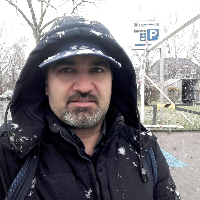The record of late quaternary climate change on magnetic susceptibility of Azadshahr Loess
Author(s):
Abstract:
Introduction
In general, loess sediments are one of the most widespread forms of eolian sediments. During the past few decades, loess stratigraphy studies played key role in global climate changes. These sediments are usually yellowish in color and silt makes 70 to 90 percent of it volume. In Iran, loesses outcrop often in northeast of south Caspian Sea. The previous studies revealed that loess/paleosol sequences correspond to cold/ warm period of climate, especially during quaternary period. Therefore, loess deposits are the most important natural archive of climate changes and are ideal for reconstruction of paleoclimate and geomorphological change in Quaternary. The thick loess/paleosol sequences of northeast Iran provide unique opportunity to reconstruct the terrestrial paleoclimate changes recorded in these sediments.A number of loesse-paleosol sequences contain a magnetic record of palaeoclimate through the Quaternary period. Anisotropy of magnetic susceptibility (AMS) was mentioned as a good tool to determine paleocurrent or paleodirection. AMS measurements were mostly used in the investigation of igneous, metamorphic and sedimentary rocks with an increasing number of applications in Quaternary loess and paleosol studies since the end of the1980s. The sediment magnetic properties depend on the magnetic content and characteristics of the source material and post-depositional weathering/soil formation processes. Loess in north of Iran is part of world loess belt and such as another loess sediments are evidence of paleoclimate change in continent.
Methodology
In this study, Azadshar (Nowdeh Loess Section) was selected to reconstruct Late Quaternary climate change. The Nowdeh loess section with about 24 m thickness were sampled in 10 cm intervals for magnetometry analysis. For this aim, sampling location and method was determined after consecutive study area. This study used of reformed review of library references and lab practices combination. Magnetic susceptibility of all samples was measured in Environmental and Paleomagnteic laboratory based at Geological Survey of Iran, Tehran, Iran. All samples were placed in an 11 cm3 plastic cylinders to be used in magnetic measurement instruments.Magnetic susceptibility was measured using AGICO company made Kappabridge model MFK1-A instrument. Magnetic susceptibility of all samples were measured. Base on this study results, samples with high frequency in magnetic susceptibility (increasing or decreasing) were selected for another studies of magnetic parameters.
Results And Discussion
The variation of magnetic susceptibility signal in the Nowdeh section suggests variation in climate conditions and mechanisms during the Late Quaternary. The magnetic susceptibility relationship with Loess/paleosol deposits resulted in low magnetic susceptibility values in cold and dry climate periods (Loess) and high magnetic susceptibility values in warm and humid climate periods (paleosoil). Therefore one can say that Loess and paleosol sequences studied here was formed at glacial and interglacial periods and under different climate condition. Results of this study showed that Magnetic Susceptibility, Natural remanent magnetization, Saturation isothermal remanent magnetization and HIRM in loess was less than paleosol. Instead amount of S_0.3 in loess layers was more than paleosol. Results of this study show that Nowdeh section has seen 8 periods of hot and humid climate (paleosol layers and similar paleosol layers with high magnetic susceptibility) in cold and dry periods (loess layers with low magnetic susceptibility) during past 150 ka.Conclusion
This study was conducted to investigate and evaluate the capability of magnetite properties in reconstruction of Late Quaternary paleoclimate condition recorded in loess/paleosol deposits of Nowdeh section in Golestan province, northeast of Iran. Nowdeh loess/paleosol sequence is an indicator for periodic dry- cool (deposition of loess) and moist-warm (formation of paleosol) conditions. Formation of the studied loess and paleosols, have probably taken place in glacial and interglacial cycles with different climatic conditions, respectively. Nowdeh section magnetic properties completely is match with Neka sediment result that has obtained by mahdipour et al (2013). In 20 to 48 ka of past years show that in two sediment sections magnetic susceptibility was similar and wherever increased, hot and humid period integrated with paleosol layer formation. Also results of this research are accordance to with bear and storm (1995) in saturation of beryllium in Xifeng section and isotope δ18 of marine sediment.this is indicate that climate change event in two section are simultaneous.Finally, should be say that magnetic properties because of depending of sensible mineral to climate change, is a very useful variable for climate change reconstruction.
Keywords:
Language:
Persian
Published:
Physical Geography Research Quarterly, Volume:48 Issue: 96, 2016
Pages:
175 to 191
magiran.com/p1607922
دانلود و مطالعه متن این مقاله با یکی از روشهای زیر امکان پذیر است:
اشتراک شخصی
با عضویت و پرداخت آنلاین حق اشتراک یکساله به مبلغ 1,390,000ريال میتوانید 70 عنوان مطلب دانلود کنید!
اشتراک سازمانی
به کتابخانه دانشگاه یا محل کار خود پیشنهاد کنید تا اشتراک سازمانی این پایگاه را برای دسترسی نامحدود همه کاربران به متن مطالب تهیه نمایند!
توجه!
- حق عضویت دریافتی صرف حمایت از نشریات عضو و نگهداری، تکمیل و توسعه مگیران میشود.
- پرداخت حق اشتراک و دانلود مقالات اجازه بازنشر آن در سایر رسانههای چاپی و دیجیتال را به کاربر نمیدهد.
In order to view content subscription is required
Personal subscription
Subscribe magiran.com for 70 € euros via PayPal and download 70 articles during a year.
Organization subscription
Please contact us to subscribe your university or library for unlimited access!


